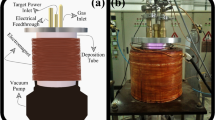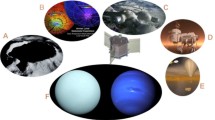Abstract
Since the discovery that muonic deuterium at energies near a few eV could travel distances of the order of 1 mm in condensed hydrogen, and in particular that muonic tritium and muonic deuterium could emerge from the surface of a solid hydrogen layer, the advantages of solid targets have enabled the study of several processes important in muon catalyzed fusion. A review of the results is presented, emphasizing the strengths and limitations of the use of solid hydrogen layer targets.
Similar content being viewed by others
References
Beer, G. A. et al., Phys. Rev. Lett. 57 (1986), 671.
Forster, B. M. et al., Hyp. Interact. 65 (1990), 1007.
Alvarez, L.W. et al., Phys. Rev. Lett. 105 (1957), 1127.
Knowles, P. E. et al., Nucl. Instrum. Methods A 368 (1996), 604.
Zmeskal, J. et al., Phys. Rev. A 42 (1990), 1165.
Scrinzi, A. et al., Phys. Rev. A 47 (1993), 4961.
Knowles, P. E. et al., Phys. Rev. A 56 (1997), 1970. See also: Knowles, P. E. et al., Hyp. Interact. 101/102 (1996), 21; Kammel, P., In: L. A. Schaller and C. Petitjean (eds), Muonic Atoms and Molecules, Birkhäuser-Verlag, Basel, 1993, p. 111; and Marshall, G. M. et al., ibid., p. 251.
Demin, D. L. et al., Hyp. Interact. 101/102 (1996), 13.
Adamczak, A., Hyp. Interact., this issue. See also: Adamczak, A. and Faifman, M. P. preprint http://xxx.lanl.gov/abs/physics/0102080 and references therein.
Gershtein, S. S., Hyp. Interact., this issue.
Mulhauser, F. et al., Phys. Rev. A 53 (1996), 3069.
Fujiwara, M. C. et al., Nucl. Instrum. Methods A 395 (1997), 159.
Faifman, M. P. and Ponomarev, L. I., Phys. Lett. B 265 (1991), 201; a subsequent calculation, including effects of quadrupole interactions, can be found in Faifman, M. P. et al., Hyp. Interact. 101/102 (1996), 179.
Fujiwara, M. C. et al., Phys. Rev. Lett. 85 (2000), 1642.
Porcelli, T. A. et al., Phys. Rev. Lett. 86 (2001), 3763.
Fujiwara, M. C. et al., Hyp. Interact. 101/102 (1996), 613.
Author information
Authors and Affiliations
Rights and permissions
About this article
Cite this article
Marshall, G.M., Adamczak, A., Bailey, J.M. et al. Advantages and Limitations of Solid Layer Experiments in Muon Catalyzed Fusion. Hyperfine Interactions 138, 203–211 (2001). https://doi.org/10.1023/A:1020835825140
Issue Date:
DOI: https://doi.org/10.1023/A:1020835825140




